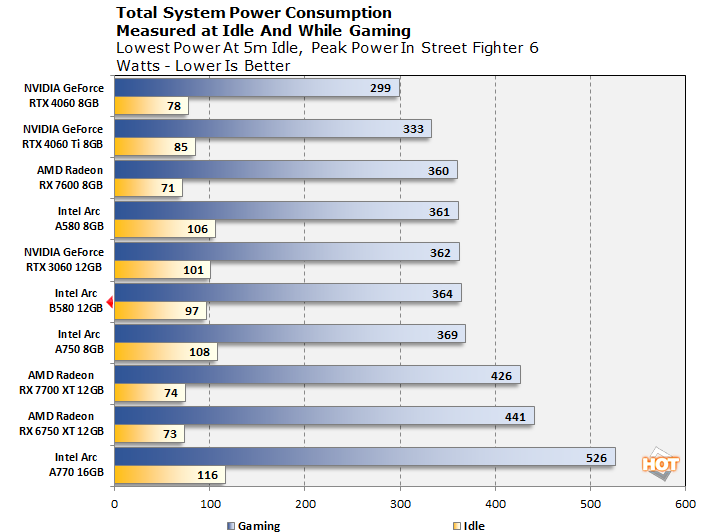Power consumption was perhaps the Achilles' Heel of Intel's previous-gen Alchemist cards. People constantly talk about driver issues and game compatibility, but both of those have been
largely solved problems for at least six months now, if not longer. Regardless, let's take a look and see if Battlemage has improved in terms of efficiency.
We have to stress a couple of things here. First and foremost is that our Arc A770 card in this test is a
factory-overclocked model that will happily suck down much more power than the Limited Edition version. Moreover, though, this is total system power we're showing here, not direct GPU power—higher frame rates mean our Core Ultra 9 CPU is working harder, too.
The efficiency of NVIDIA's Ada Lovelace GPUs continues to impress, but keep in mind the performance we just saw on the last two pages and now look at that power chart again. The Arc B580 is running just a bit warmer than the GeForce RTX 4060 Ti, yet it was ahead of or very close to that card in almost every single test. Sure, it's a newer product, but NVIDIA still has a process node advantage on the B580—those parts are produced on TSMC's 4N node, while Battlemage is on TSMC N5.
Given these kinds of power figures and the big dual-fan cooler on our card, it should come as no surprise that neither noise nor thermals are ever a consideration. When the card heats up a bit, the fans inaudibly kick on and blow cool air across the heatsink until the GPU takes a break. Admittedly, it helps that the temperature in our test chamber is about 65°F (18°C) right now, but we can't imagine anyone complaining about the noise or heat output of one of these new Intel GPUs.
Intel's Arc B580: Our Conclusions And Key Takeaways
With Alchemist, Intel needed to prove that it could make a more competent, powerful GPU, and indeed the company succeeded. A lot of people probably came into this review with lower expectations. After all, Arc as a gaming graphics card brand hasn't exactly stood out in the crowd, at least before today.
In case you haven't picked up on it yet, we're very impressed by Intel's new Arc B580 card. It's not flawless; the issues we saw with Selaco and Guardians of the Galaxy are the kind of thing that you really don't see much anymore with an AMD or NVIDIA GPU. It's darn close to flawless, though. The Arc B580's performance and efficiency are both surprisingly very strong, and we haven't even touched on overclocking the thing yet.
If you're looking for a GPU upgrade in the $250 range, and you're currently on an aging NVIDIA or AMD card, you almost couldn't do better for price-performance than to grab one of these at MSRP. It's hard to deny that one of these Arc B580 cards presents a more compelling value proposition than the Radeon RX 7600, even a 16GB XT model. Not only is the performance quite a bit better overall, you also get advanced AI features in the form of XeSS upscaling and frame generation, and ray tracing performance is strong, too.
Availability of these new Intel graphics cards starts today, but inventory hasn't quite shown up in most places just yet. Still,
keep an eye out. As long as they arrive at MSRP, we're prepared to call Intel's second-generation Arc B580 GPUs a full-on reversal of the company discrete graphics card fortunes, and we hope this isn't the last we see of Battlemage. A bigger version of this GPU could well be a seriously powerful contender in the midrange gaming graphics card space.



